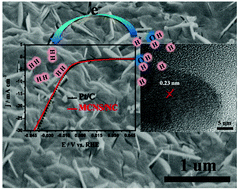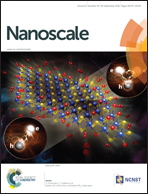Ultra-efficient electrocatalytic hydrogen evolution at one-step carbonization generated molybdenum carbide nanosheets/N-doped carbon†
Abstract
The hydrogen evolution reaction (HER) from water through electrocatalysis using highly active noble metal-free catalysts as an alternative to precious Pt-based catalysts holds great promise for clean and renewable energy systems. Here, Mo2C nanosheets well-regulated in N-doped carbon (MCNS/NC)are facilely achieved by in situ confining carburization of a Mo-based inorganic–organic lamellar mesostructure at 900 °C, and demonstrated for the first time as an ultra-efficient and durable HER catalyst. The MCNS/NC displays a very low onset overpotential of ∼0 mV and an overpotential of 19 mV at 10 mA cm−2 with a small Tafel slope of 28.9 mV dec−1 in acid media, which is remarkably superior to most other transition metal-based catalysts and comparable to commercial Pt/C. The HER kinetics are further studied by EIS and Tafel slope analysis, suggesting the dominant Volmer–Tafel mechanism. An “outside-in” carburization mechanism for the evolution of MCNS/NC is proposed through detailed investigation of the samples annealed at different temperatures. This study highlights the importance of designing well-regulated functional nanostructures combined with a conductive carbonaceous matrix for versatile applications.


 Please wait while we load your content...
Please wait while we load your content...